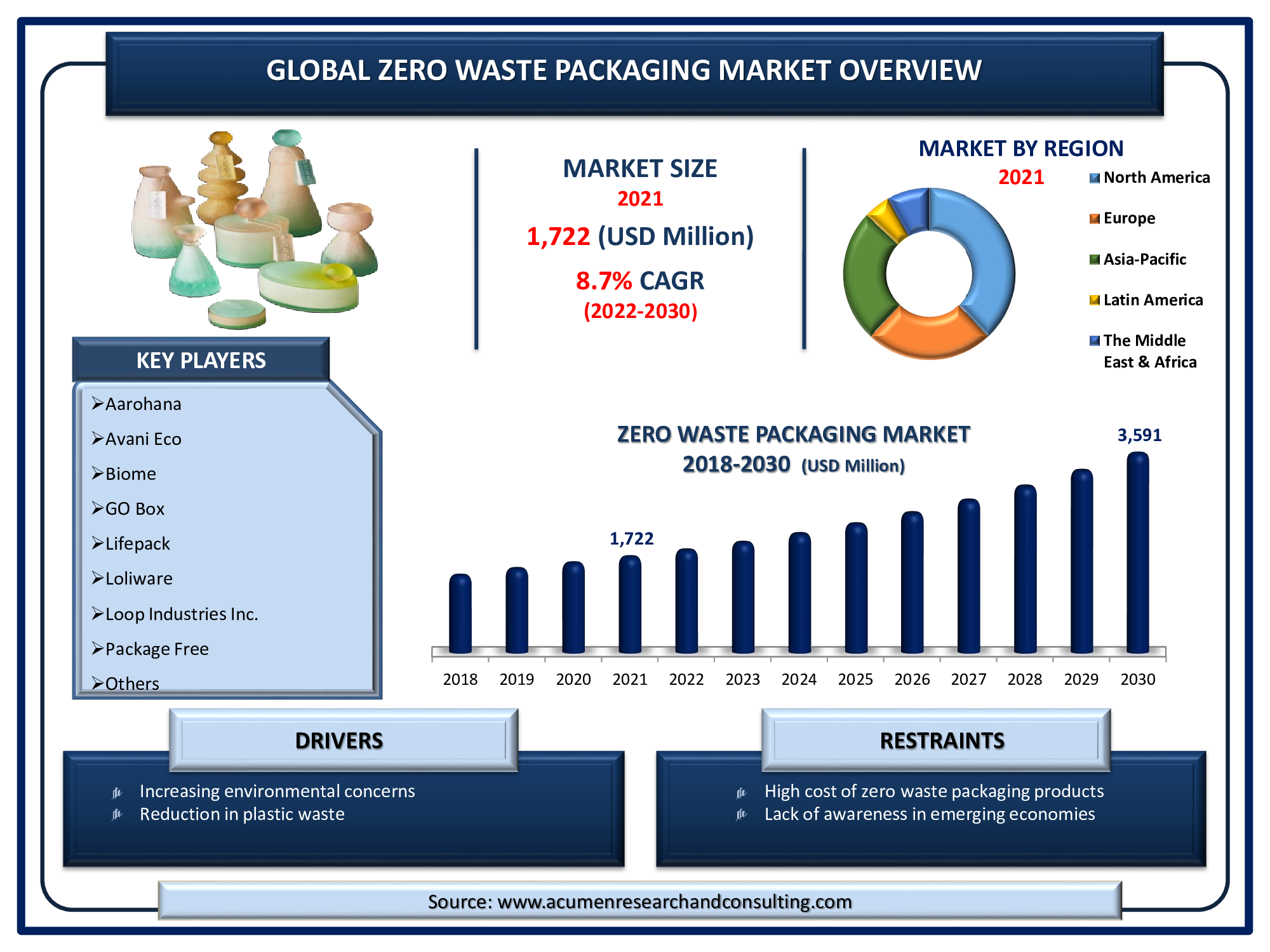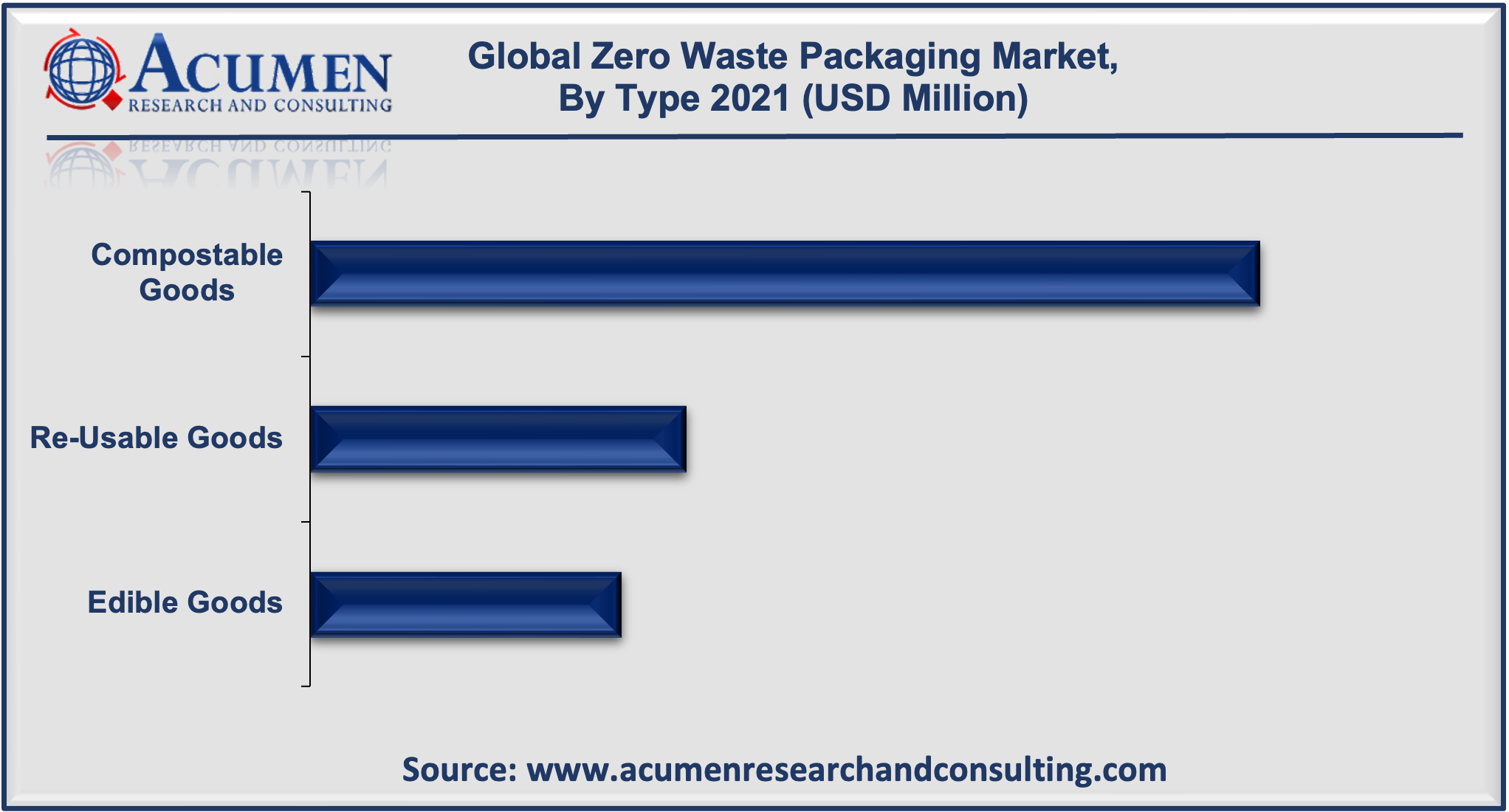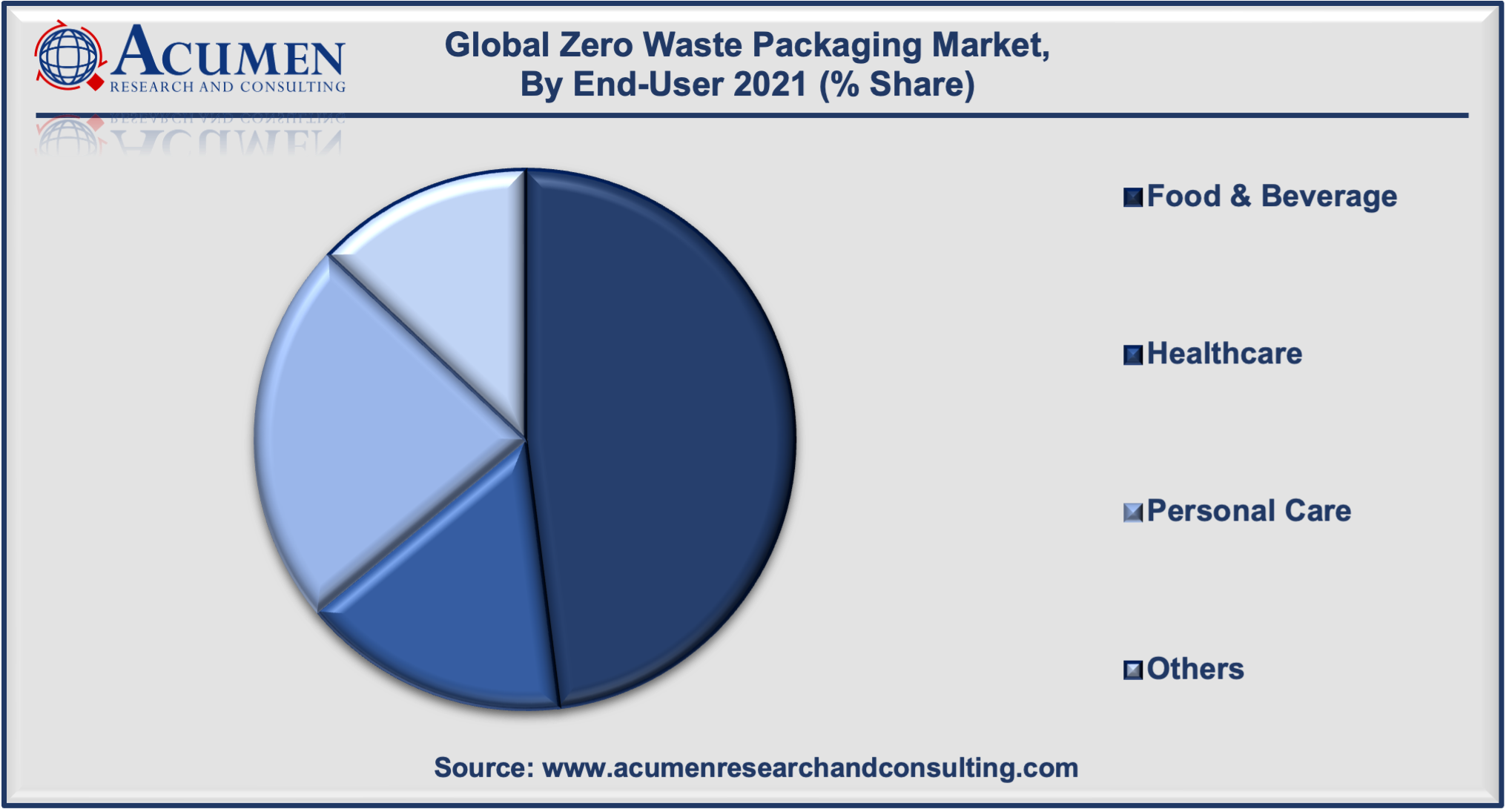April 2020
Zero Waste Packaging Market is estimated to reach USD 3,591 Mn by 2030, with a CAGR of 8.7% from 2022 to 2030.
The Global Zero Waste Packaging Market size accounted for USD 1,722 Mn in 2021 and is estimated to reach USD 3,591 Mn by 2030, with a CAGR of 8.7% from 2022 to 2030.

Zero-waste involves creating and managing products and processes to avoid and eliminate waste and material volume and toxicity, conserve and recover all resources, and not bury or burn them. Zero-waste packaging is defined as packaging wherein every component is reused or recyclable, resulting in no actual waste. This could indicate that the packaging is intended to be reused by the consumer, such as an edible container, "plantable" paper embedded with seeds, or packets that can be sent to local drop-off sites for re-use. While any type of packaging will contain some sort of residual component, there are creative ways to turn the packaging process into a zero-waste operation. Surging demand for sustainable packaging solutions is one of the significant trends in the zero waste packaging market.
Zero Waste Packaging Market Dynamics
Market Growth Drivers:
Market Restraint:
Market Opportunities:
Report Coverage
| Market | Zero Waste Packaging Market |
| Market Size 2021 | USD 1,722 Mn |
| Market Forecast 2030 | USD 3,591 Mn |
| CAGR During 2022 - 2030 | 8.7% |
| Analysis Period | 2018 - 2030 |
| Base Year | 2021 |
| Forecast Data | 2022 - 2030 |
| Segments Covered | By Type, By Distribution Channel, By End-User, And By Geography |
| Regional Scope | North America, Europe, Asia Pacific, Latin America, and Middle East & Africa |
| Key Companies Profiled | AarohanaEcosocial Development, Avani Eco, Biome, GO Box, Lifepack, Loliware, Loop Industries Inc., Package Free, PulpWorks Inc., and World Centric. |
| Report Coverage |
Market Trends, Drivers, Restraints, Competitive Analysis, Player Profiling, Regulation Analysis |
| Customization Scope |
10 hrs of free customization and expert consultation |
The rising concern of growing packaging waste is the primary factor driving the worldwide zero waste packaging market share. As the world's population expands, so does the amount of waste produced. According to the Environmental Protection Agency (EPA), plastic mass production, which began only six decades ago, has grown to the point where 8.3 billion metric tonnes have been produced, the most of which are in single-use items that end up as waste. In around 30 years, world’s landfills might contain more than 12 billion tonnes of plastic. Among then, approximately 8 million metric tonnes of plastic garbage end up in the oceans each year. Even though plastic is technically a recyclable material, recycling it is economically inefficient and unwanted because it is significantly cheaper to create new things from start. For instance, only 8.7% of all plastic waste was recycled in 2018 in the US. Among them, only plastic bottles are regularly recycled.
Significant shift of businesses towards sustainable packaging is expected to boost the zero waste packaging market revenue. Conscious firms, leaders, and consumers would not like to contribute to packaging waste, so there is a lot of discussion about more sustainable options. Cutting plastic from packaging can help reduce the quantity of plastic consumer use and discard. As a result, doing so can reduce the amount manufactured each year. As a result, significant companies focus on employing cardboard, craft paper tape, and recycled paper as go-to packaging materials. Craft paper tape will reduce the quantity of plastic packaging that ends up in landfills because it is composed of recycled paper.
However, high cost related to zero waste packaging materials may act as a restraining factor in the market. Currently, zero waste materials are more expensive than plastic waste, but this does not require additional expenses such as funding to clear the waste.For instance, according to the World Economic Forum data, the waste form plastic packaging costs $80 to $120 billion loss every year. Furthermore, the rapidly expanding food & beverage industry coupled with the rising e-commerce sales are some of the factors that are likely to generate several growth prospects for the market in the coming years.
Zero Waste Packaging Market Segmentation
Type, distribution channel, end-user, and geography are all used to segment the worldwide zero waste packaging market.
Market by Type

On the basis of type, compostable goods segment generated the largest zero waste packaging market revenue in 2021. This could be attributed to increased knowledge and concern about the importance of trash among the worldwide population, which can have negative consequences on the environment. As a result, the need for compostable items as a realistic alternative to other disposable items for waste disposal has increased. Additionally, compostable packaging is preferred in foodservice packaging for restaurants, grocery stores, cafeterias, closed loop venues, and prepared food bars, thereby driving its demand.
Market by Distribution Channel
Based on distribution channels, the supermarkets/hypermarkets segment gathered significant amount of zero waste packaging market shares in 2021. The high growth in the segment is witnessed due to the easy availability of variety of goods in super and hyper markets. In addition, there is a continuation of consumers to purchase groceries and fruit & vegetables from supermarket & hypermarkets, which also supports the industry growth. On the other hand, the online channel segment is expected to attain the fastest growth rate throughout the forecast period. The market for online channel is growing due to the steady rise in the number of individuals globally who are purchasing products by transacting through the online mode.
Market by End-User

Based on end-user, the food & beverages segment dominated the market with significant shares throughout the forecast timeframe. The pandemic had a significant impact on the food and beverage industries. Since the Covid-19 outbreak, several food and beverage establishments have increased their use of zero-waste packaging materials. During and after the lockdown, a large number of people shifted to online grocery shopping, which increased demand for zero-waste packaging.
Zero Waste Packaging Market Regional Overview
North America
Europe
Latin America
Asia-Pacific
The Middle East & Africa (MEA)
Rising Government Initiatives Regarding Environment Boost The North America Zero Waste Packaging Market Growth
According to regional analysis, North America will account for the largest market share in 2021, owing to increased awareness among individuals in the United States and Canada about the environmental impact caused by plastic trash. In addition, various measures launched by governments in the region to manage environmental trash are expected to support market growth in the region over the next few years. On the other hand, the Asia-Pacific region is anticipated to attain the fastest growth rate (CAGR) during the forecast timeframe from 2022 to 2030. Increased disposable income, rising demand for consumer goods such as soft drinks and textiles, and manufacturing establishment in the region are expected to boost market expansion.
Zero Waste Packaging Market Players
Some of the top zero waste packaging companies offered in the professional report include AarohanaEcosocial Development, Avani Eco, Biome, GO Box, Lifepack, Loliware, Loop Industries Inc., Package Free, PulpWorks Inc., and World Centric.
Looking for discounts, bulk pricing, or custom solutions? Contact us today at sales@acumenresearchandconsulting.com
April 2020
April 2020
March 2020
June 2024